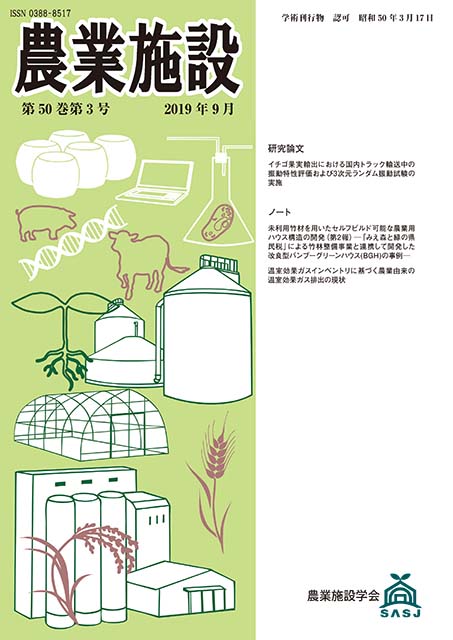All issues

Volume 50 (2019)
- Issue 4 Pages 140-
- Issue 3 Pages 99-
- Issue 2 Pages 51-
- Issue 1 Pages 1-
Volume 50, Issue 3
Vol. 50, No. 3 (Ser. No. 162)
Displaying 1-3 of 3 articles from this issue
- |<
- <
- 1
- >
- >|
-
Nobutaka NAKAMURA, Kohei SAKAMOTO, Tomoko KANETA, Masayasu NAGATA, Tak ...2019Volume 50Issue 3 Pages 99-106
Published: 2019
Released on J-STAGE: September 28, 2023
JOURNAL OPEN ACCESSVibration analysis of the domestic transportation process was conducted on strawberries which was meant for export. Acceleration within a cardboard box on a truck bed during transportation was measured from the produce growing area (Ibaraki pref.) to Yokohama Port (Kanagawa pref.), and the power spectral density (PSD) of acceleration was calculated. Using this PSD data, 3-dimensional vibration tests were conducted, and four types of multi-stacked packages consisting of different combinations of the outer boxes and inner trays were evaluated for physical damage to the fruit along with calculation of Grms (root mean squared value of acceleration) in the outer boxes. The salable rate of fruits after the vibration test differed by package type and stacked position from 7.7% to 86.7%. The damage score of fruit and Grms were both higher in the upper layer than in the lower layer. These results show the importance of adequate packaging design for transportation of the fruit to reduce distribution losses. Furthermore, Grms is a benefi cial index of the distribution conditions that explains physical damage loss of fresh produce.View full abstractDownload PDF (1147K) -
-Case Study on “Improved Kumano Bamboo Greenhouses” Built by Cooperation with Bamboo Forest Maintenance Project in Kishu Region, Mie Prefecture-Shingo NAGANO, Hirohide KOBAYASHI, Mari MIYAJI2019Volume 50Issue 3 Pages 107-116
Published: 2019
Released on J-STAGE: September 28, 2023
JOURNAL OPEN ACCESSPreviously, we built self-buildable and low cost greenhouses using bamboo called “Kumano Bamboo Greenhouses (BGHs)” experimentally in Kumano city, Mie prefecture. We reported cost for materials could be lower than steelpipe house by using bamboo, however construction work needs longer time than that of steel-pipe house. Moreover, Ito et al. (2010) noted cost of procurement for bamboo using materials as unused natural resources was needed. The objective of this study was to decrease time for construction work improving BGH structure and to decrease procurement cost for material bamboo cooperating with administrative organization. Materials costs for both BGH No. 3 and BGH No. 4 were lower than that of BGH No.2. This is approximately half that of a steel-pipe house. BGH No. 3 and BGH No. 4 could be built in 138.4 and 77.2 hours respectively, time for construction work could decrease by that in BGH No.2 needed 264 hours. The calculation of structural strength was diffi cult because of the variability of dryness and degradation of bamboo materials. However, critical damages have not been observed in either BGHs during the 20 months post-construction. In BGH No. 4, horizontal oscillation by side wind was observed. From these results, it is found that material cost included procurement of bamboo for BGHs produced in this study (BGH No. 3 and BGH No. 4) and time for construction work could be decreased than that of BGH No. 2. These BGHs can be self-built at a small-scale, irregular-shaped farmland, so they may be useful for agriculture promotion in mountain villages. Moreover, cooperation with maintenance of bamboo grove could not decrease cost for BGH building but also help to prevent animal damage and conserve the traditional landscape of farming.View full abstractDownload PDF (2756K) -
Ryota TSUCHIYA, Limi OKUSHIMA2019Volume 50Issue 3 Pages 117-125
Published: 2019
Released on J-STAGE: September 28, 2023
JOURNAL OPEN ACCESSVarious measures are taken globally to mitigate the impact of global warming by reducing the emission of greenhouse gasses (GHG). Agriculture is a GHG source with CO2 emissions from fossil fuels consumed in agricultural facilities and machineries, and CH4 emissions from livestock and farmland. In the National Greenhouse Gas Inventory of Japan, these GHG sources are separately classifi ed into the energy sector and the agriculture sector. Thus, it is not possible to directly discuss the current situation of all agricultural GHG emissions using this inventory. In this research, the detailed emissions of GHG from agriculture in Japan are analyzed using the inventory and other data sources. As a result, paddy fi elds were found to be the largest source of GHG emissions in Japan. Conversely, consuming fossil fuels in agricultural production is also an important source and accounts for a third of total agricultural emissions. GHG emissions per agricultural management entity are the largest in the livestock industry for total and the agriculture sector, though they are the largest in protected agriculture for the energy sector.View full abstractDownload PDF (924K)
- |<
- <
- 1
- >
- >|